| Genesis Feature Examples |
Written by geologist for geologist
Genesis is written by geologist to be used by the ordinary geologists. The interactive nature makes what if and sensitivity analysis fast and easy. Modern metaphors allow user to input and manipulate data as graphical objects (e.g. drawing data points with a pencil). Professional quality graphics directly go into your Word report or PowerPoint presentations.
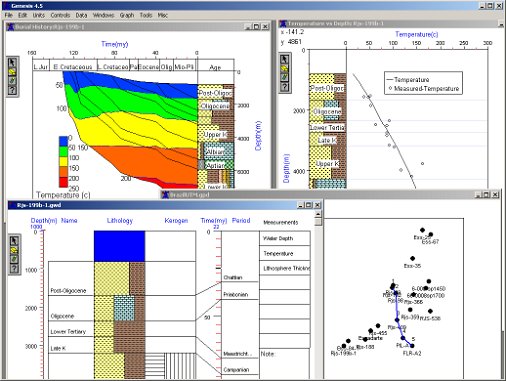
Easy to use
You can build a model graphically by clicking of the mouse or the stratigraphy can be typed in Excel, then pasted into Genesis.Measurements (Ro, temperature, etc.) can also be entered the same way from spreadsheets, or imported from ASCII files.
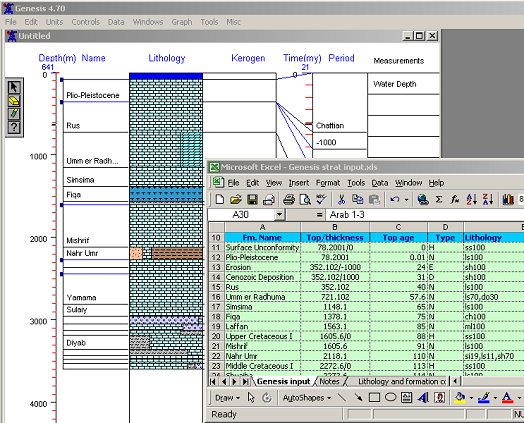
Unique way of using lithologies
You can build a lithology mix by clicking in the histogram. Unique mixing model preserves the properties of end member lithologies and save the user from having to calibrate every possible mix. Layers of different lithologies for each formation are truly models as layers rather than averaging the parameters as some models do.
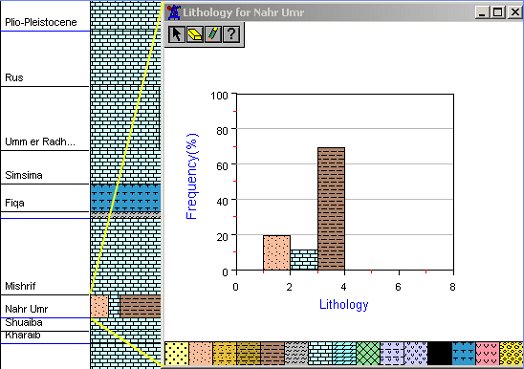
The kerogen lithofacies database
A result of a research program at ARCO. User may choose a litho-facies and Genesis will mix default kerogens to represent the kinetic behavior in order to better predict maturity of the unknown source rock. The mixing can be fine-tuned to match well data (basic Rock-Eval) for more accurate maturity prediction.
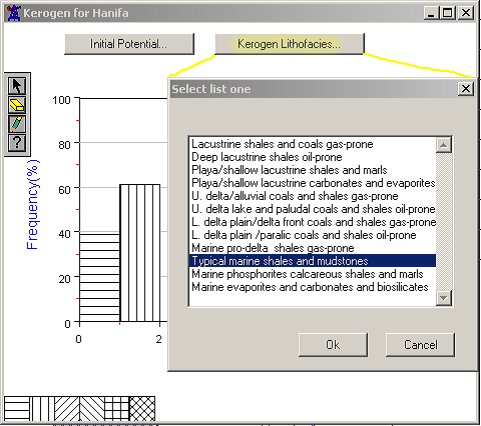
Visual calibration
Measured vs. calculated plots let users calibrate the model visually. Change the model inputs, click Execute, the results will update automatically. Error bars and labels can be input for measured data. This makes it easy to compare and calibrate model paying particular attention to certain kinds of data.

Quartz cementation modeling in Genesis
ARCO researchers improved Walterhaug's quartz cementation model by inverting the first order kinetics parameters. Quartz cementation is a function of Time, temperature, grain size and quartz content. It is coupled with the Genesis fluid flow model that accounts for compaction dis-equilibrium. User can map quartz cement along with other variables (T, P, HC generation etc.) on burial histories. Making it an effective tool for illustrating relative timing of reservoir cementation and HC charge.
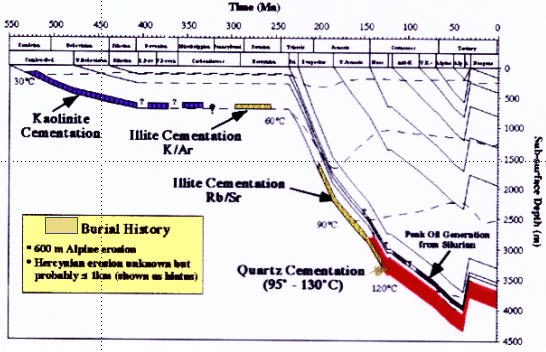
Improved rifting heat flow modeling
Other basin model's implementation of McKenzie rift model multiplies beta to the total heat flow prior to rifting to obtain HF at time of rifting. Predicts generation at depth of 1200 m during Cretaceous in Campos basin. Genesis only applies McKenzie model to the heat flow from mantle and at the same time allows the radiogenic heat from lithosphere to be reduced by stretching. Predicts generation at present in Campos basin.
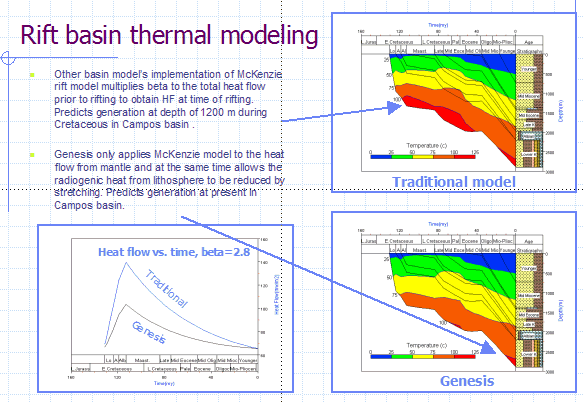
Lithosphere based transient heat flow
Transient effects can only be modeled by accounting for the thickness of the entire lithosphere. Genesis allows a temperature boundary to be specified at the bottom of lithosphere and heat flow be predicted as a result. This allows the user to predict heat flow away from well control and also through geological time.
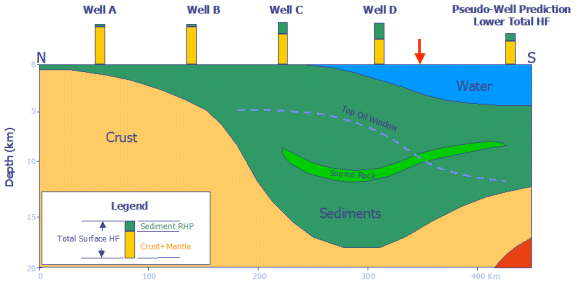
Lithology mixing and pressure prediction
Unique lithology mixing model that does not require calibration of new mixes. Other basin models mix lithologies without calibration. This feature improves compaction dis-equilibrium modeling and accuracy of pressure prediction. Density and velocity calculations can be calibrated using log/seismic data.

Multi-well project design
Map based project view lets you quickly access well models simply by clicking on the well location. Multiple wells can be plotted on the same plot for comparison. Or different scenarios of the same well model can be compared.
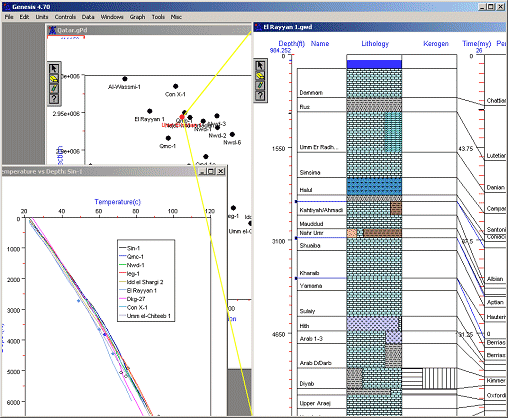
Maps and cross sections
User can make paleo-cross sections and maps of over 80 different variables. Calculated values can be contoured or shown as bubble maps. Calculated values can be painted on cross sections to show temperature, maturity, etc.
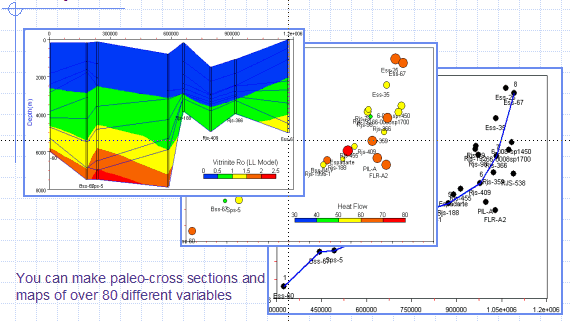
Calculates over 80 different parameters
Genesis models many geological parameters of interests to explorationists. Here is a list of the parameters calculated as of version 4.7.
|
Density (Rock Grain),g/cm3 Density of Oil Expelled,g/cm3 Density of Oil Remaining,g/cm3 Density of Rock (Bulk),g/cm3 Density of Water,g/cm3 Effective Stress,MPa Effective Stress (Maximum),MPa Expulsion Efficiency,% Flow Velocity (Water),cm/my Flux of Water (Cumulative),cm3 Flux of Water (Vertical),cm3/my Fractions of Each Lithology,fraction Fractions of Each Kerogen Type,fraction Gas Expelled,mg/g rock Gas Expelled (C2-C5),mg/g rock Gas Expelled (Methane),mg/g rock Gas Generated,mg/g TOC Gas Generated (C2-C5),mg/g rock Gas Generated (Methane),mg/g rock Gas Generation Rate,mg/g rock/my Geothermal Gradient,C/100m GOR of Expelled Products,scf/bbl GOR of Residual Products,scf/bbl Heat Capacity (Bulk),cal/g C Heat Flow,cal/g.cm2.s Hopane H1,fraction Hydraulic Potential,MPa |
Hydrogen Index,mg/g TOC Oil Expelled,mg/g rock Oil Expelled (C15+),mg/g rock Oil Expelled (C6-C15),mg/g rock Oil Generated,mg/g rock Oil Generated (C15+),mg/g rock Oil Generated (C6-C15),mg/g rock Oil Generation Rate,mg/g rock/my Permeability (Average Vertical),md Porosity (Bulk),fraction Porosity of Each Lithology,fraction Pressure (Capillary Entry),MPa Pressure (Excess),MPa Pressure (Fluid),MPa Pressure (Hydrostatic),MPa Pressure (Total Overburden),MPa Pressure Gradient,MPa/m Production Index,fraction Quartz cement,fraction Rate of HC Expulsion,mg/g Rock Ratio of Atomic H/C (LL Model), Ratio of Atomic O/C (LL Model), Remaining Potential,mg/g TOC Residual Coke Generated,mg/g TOC S1,mg/g Rock S2,mg/g Rock Saturation (HC),fraction |
Seal capacity (oil column),m Seal capacity (gas column),m Solid Hydrocarbon Reflectance,% Sterane A1,fraction Sterane A3,fraction Sterane S1,fraction Sub-Layer Thickness,meters Subsidence (Tectonic),meters Subsidence (Total),meters Subsiding Velocity (Matrix),m/my Surface Temperature,C Temperature,C Thermal Conductivity (Bulk),cal/cm2.s.C Thermal Gradient,C/m Tmax,C TOC (Remaining),% Transformation Ratio (HC),fraction Transformation Ratio (TG),fraction TSI, TTI (Waples Model), User Biomarker A,fraction User Biomarker B,fraction Velocity (Acoustic),m/s Vitrinite Ro (ARCO),% Vitrinite Ro (LL Model),% Vitrinite Ro (Waples Model),% Vitrinite Ro (BP),% |
©2001, ZetaWare, Inc. All rights reserved